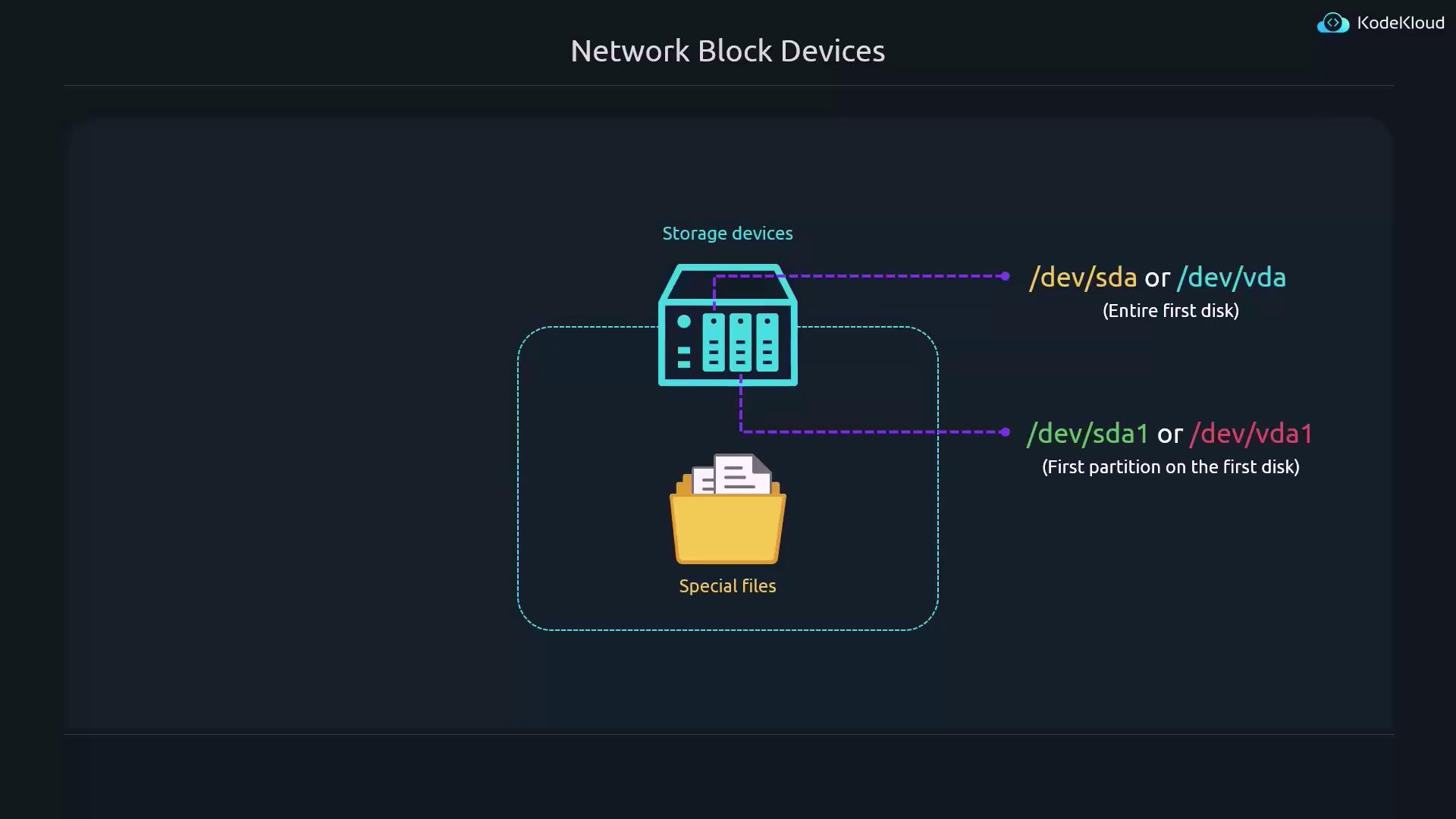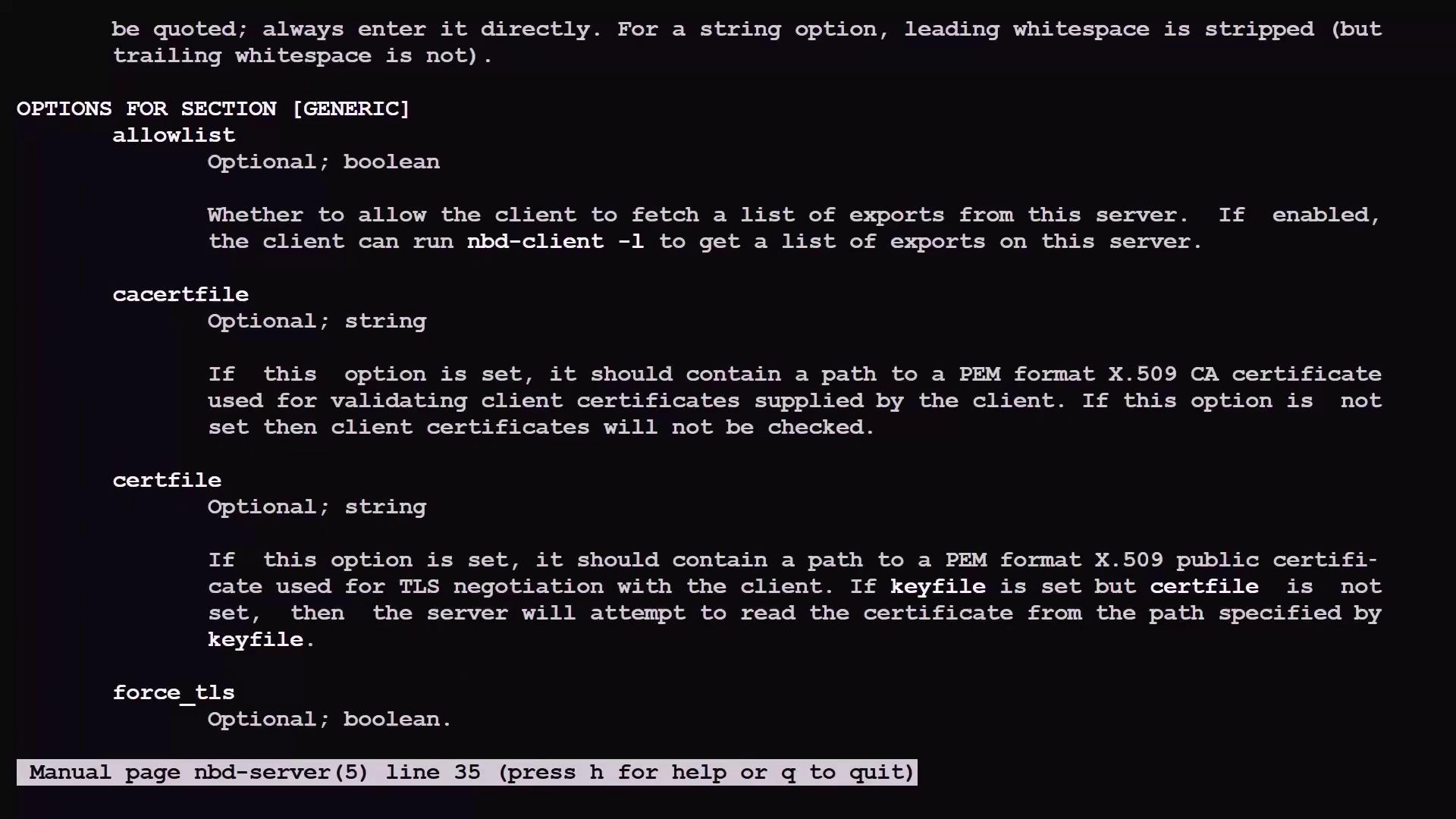Linux Foundation Certified System Administrator (LFCS)
Storage
Use Network Block Devices NBD
In this lesson, you'll learn how to mount remote block devices using Network Block Devices (NBD). This method allows your local system to access a storage device that physically resides on a different machine, thereby extending storage capabilities across your network.
Special files in Linux typically reference local storage devices. For example, /dev/sda or /dev/vda represents the entire first storage device, while /dev/sda1 or /dev/vda1 refers to a specific partition on that disk.

NBDs function similarly to local block special files; however, they map remote storage devices over the network. Consider the following scenario with two servers:
- Server 1 has two storage devices:
/dev/vdaand/dev/vdb. - Server 2 also provides two storage devices with similar identifiers.
With NBD, Server 1 can seamlessly incorporate a third disk that physically resides on Server 2. The NBD tools create a special file (e.g., /dev/nbd0), which applications treat as a standard block device, while all read and write operations on /dev/nbd0 are transparently forwarded to the actual block device (e.g., /dev/vdb) on Server 2.

Below, we cover how to configure both the NBD server (the system that shares its block device) and the NBD client (the system that connects to and uses the remote block device).
Configuring the NBD Server
Follow these steps on the server that will export the block device:
Install NBD Server Package
Use the package manager to install the NBD server:
sudo apt install nbd-serverA sample output could be similar to:
jeremy@kodekloud:~$ sudo apt install nbd-server Reading package lists... Done Building dependency tree... Done Reading state information... Done The following NEW packages will be installed: nbd-server 0 upgraded, 1 newly installed, 0 to remove and 1 not upgraded. Need to get 63.3 kB of archives. After this operation, 184 kB of additional disk space will be used. Get:1 http://us.archive.ubuntu.com/ubuntu noble-updates/main amd64 nbd-server amd64 1:3.26.1-1ubuntu0.1 [63.3 kB] Fetched 63.3 kB in 1s (72.9 kB/s) Preconfiguring packages ... Selecting previously unselected package nbd-server. (Replacing database ... 145155 files and directories currently installed.) Preparing to unpack .../nbd-server_1%3a3.26.1-1ubuntu0.1_amd64.deb ... Unpacking nbd-server (1:3.26.1-1ubuntu0.1) ... Setting up nbd-server (1:3.26.1-1ubuntu0.1) ... Creating config file /etc/nbd-server/config with new version info: Selecting UID from range 100 to 999 ... info: Selecting GID from range 100 to 999 ... info: Adding system user `nbd' (UID 112) ... info: Adding new group `nbd' (GID 113) ... Progress: [ 60%] [#################################################......................]Edit the NBD Configuration
Open the configuration file using your preferred text editor:
sudo vim /etc/nbd-server/configBy default, the NBD daemon runs as the user
nbd, which might not have access to block devices like/dev/sda. The configuration contains comments guiding you to run the daemon asrootif necessary. You can either explicitly set the user and group asrootor comment out these lines entirely. For instance:[generic] # If you want to run everything as root rather than the nbd user, you # may either say "root" in the two following lines, or remove them # altogether. Do not remove the [generic] section, however. # user = nbd # group = nbd includedir = /etc/nbd-server/conf.d allowlist = true # What follows are export definitions. Your section header must be unique. [partition2] exportname=/dev/sda1In this example, the export definition under
[partition2]specifies that/dev/sda1will be shared. Make sure the device path matches your intended configuration.Restart the NBD Daemon
Save your changes and restart the NBD server to apply the new configuration:
sudo systemctl restart nbd-server.serviceFor more configuration options, consult the manual:
man 5 nbd-serverThis manual details generic and export-specific settings.

Configuring the NBD Client
On the client machine where you want to access the remote block device, complete the following steps:
Install NBD Client Package
Install the NBD client utilities:
sudo apt install nbd-clientSample output might look like:
Need to get 43.5 kB of archives. After this operation, 131 kB of additional disk space will be used. Get:1 http://us.archive.ubuntu.com/ubuntu noble/universe amd64 nbd-client amd64 1:3.26.1-1build1 [43.5 kB] Fetched 43.5 kB in 1s (44.2 kB/s) Preconfiguring packages ... Selecting previously unselected package nbd-client. (Reading database ... 83311 files and directories currently installed.) Preparing to unpack .../nbd-client_1%3a3.26.1-1build1_amd64.deb ... Unpacking nbd-client (1:3.26.1-1build1) ... Setting up nbd-client (1:3.26.1-1build1) ... update-initramfs: deferring update (trigger activated) update-rc.d: warning: start and stop actions are no longer supported; falling back to defaults Processing triggers for man-db (2.12.0-4build2) ... Processing triggers for initramfs-tools (0.142ubuntu25) ... update-initramfs: Generating /boot/initrd.img-6.8.0-31-generic Scanning processes... Scanning linux images... Running kernel seems to be up-to-date. No services need to be restarted. No containers need to be restarted. No user sessions are running outdated binaries. No VM guests are running outdated hypervisor (qemu) binaries on this host. jeremy@kodekloud:~$Load the NBD Kernel Module
To support remote block devices, load the necessary kernel module:
sudo modprobe nbdThis module will load for the current session only. To load it automatically at boot, add it to the modules configuration:
sudo vim /etc/modules-load.d/modules.confThen insert the following line:
nbdSave and exit the file.
Connect to the Remote Block Device
Establish an NBD connection by specifying the server's IP and the export name with the
-Noption (for example,partition2):sudo nbd-client 127.0.0.1 -N partition2The expected output might look as follows:
$ sudo nbd-client 127.0.0.1 -N partition2 Negotiation: ..size = 2048MB Connected /dev/nbd0 jeremy@kodekloud:~$The special file
/dev/nbd0now represents the remote block device. Every operation on/dev/nbd0is forwarded to the designated block device on the server.Mount the Remote Block Device
Treat the remote block device like any local one. For instance, mount it to the
/mntdirectory:sudo mount /dev/nbd0 /mnt ls /mntA sample listing might display the files on the mounted block device:
jeremy@kodekloud:~$ sudo mount /dev/nbd0 /mnt jeremy@kodekloud:~$ ls /mnt config-6.8.0-31-generic config-6.8.0-35-generic grub initrd.img initrd.img-6.8.0-31-generic initrd.img-6.8.0-35-generic lost+found System.map-6.8.0-31-generic System.map-6.8.0-35-generic vmlinuz vmlinuz-6.8.0-31-generic vmlinuz-6.8.0-35-generic vmlinuz.oldDetach the Remote Block Device
When it’s time to disconnect the remote device, follow these steps:
Unmount the file system:
sudo umount /mntVerify block device status:
lsblkThe output should show
/dev/nbd0with a non-zero size.Detach the NBD connection:
sudo nbd-client -d /dev/nbd0
Running
lsblkagain should indicate that/dev/nbd0now has a zero-byte size, confirming successful detachment.An example session might be:
jeremy@kodekloud:~$ sudo umount /mnt jeremy@kodekloud:~$ lsblk NAME MAJ:MIN RM SIZE RO TYPE MOUNTPOINTS sda 8:0 0 45G 0 disk ├─sda1 8:1 0 1M 0 part /boot ├─sda2 8:2 0 2G 0 part └─sda3 8:3 0 21.5G 0 lvm / sr0 11:0 1 1024M 0 rom nbd0 43:0 0 2G 0 disk ... jeremy@kodekloud:~$ sudo nbd-client -d /dev/nbd0 jeremy@kodekloud:~$ lsblk NAME MAJ:MIN RM SIZE RO TYPE MOUNTPOINTS sda 8:0 0 45G 0 disk ├─sda1 8:1 0 1M 0 part /boot ├─sda2 8:2 0 2G 0 part └─sda3 8:3 0 43G 0 part sr0 11:0 1 1024M 0 rom nbd0 43:16 0 0B 0 disk ...List Available Exports
To view all available exports on the NBD server, use the
-loption:sudo nbd-client -l 127.0.0.1Example output:
jeremy@kodekloud:~$ sudo nbd-client -l 127.0.0.1 Negotiation: .. partition2This capability is enabled by the
allowlist = truesetting in the generic section of the NBD server configuration.
Summary
In this lesson, you learned how to export a local block device using an NBD server and connect to it remotely via an NBD client. Here’s a quick reference table summarizing the process:
| Step | Action | Command Example |
|---|---|---|
| Install NBD Server | Set up the NBD server package | sudo apt install nbd-server |
| Edit NBD Configuration | Configure export definitions and user settings | sudo vim /etc/nbd-server/config |
| Restart NBD Daemon | Apply configuration changes | sudo systemctl restart nbd-server.service |
| Install NBD Client | Set up the NBD client utilities | sudo apt install nbd-client |
| Load NBD Kernel Module | Enable kernel support for remote block devices | sudo modprobe nbd |
| Connect Remote Block Device | Attach the remote block device over the network | sudo nbd-client 127.0.0.1 -N partition2 |
| Mount Remote Block Device | Mount the associated device to your local filesystem | sudo mount /dev/nbd0 /mnt |
| Detach Remote Block Device | Safely disconnect the NBD device | sudo nbd-client -d /dev/nbd0 |
| List Available Exports | Discover available exports on the NBD server | sudo nbd-client -l 127.0.0.1 |
This completes the core concepts of using Network Block Devices. Armed with these instructions, you can now export local block devices from one server and mount them remotely on another.
Let's move on to our next lesson.
Watch Video
Watch video content